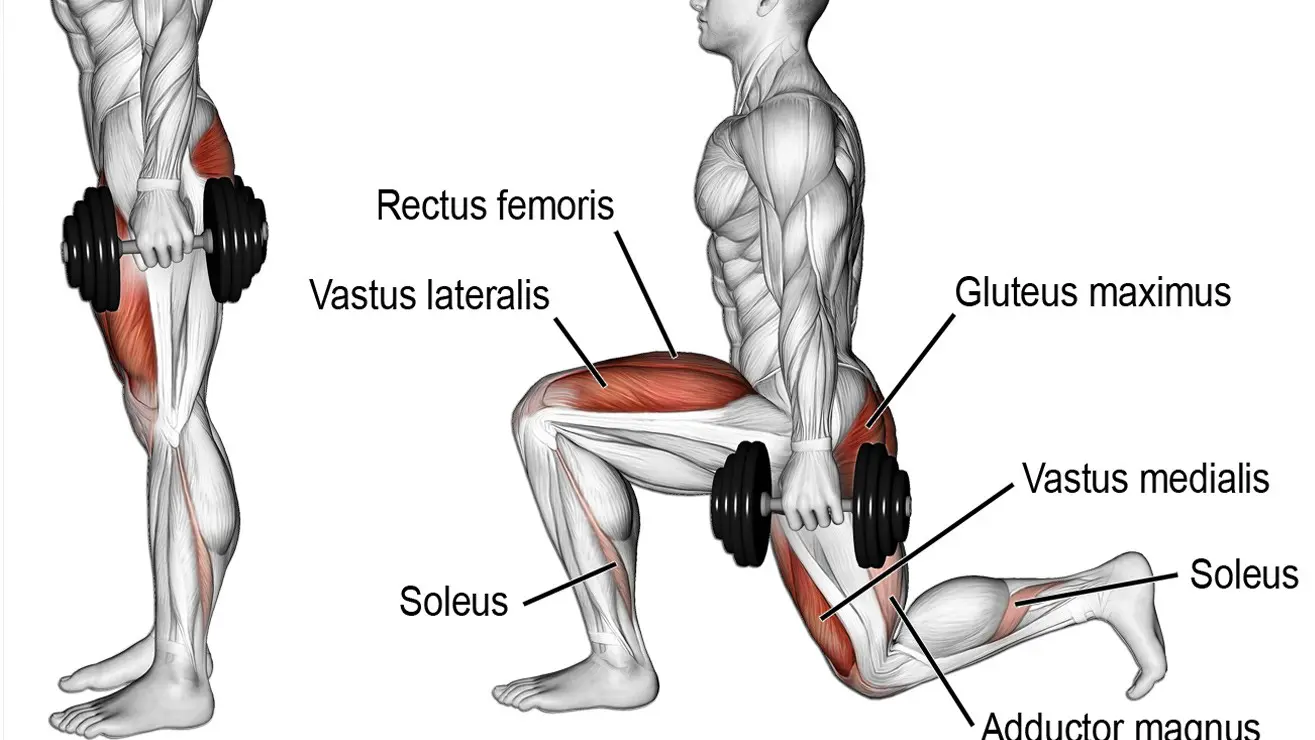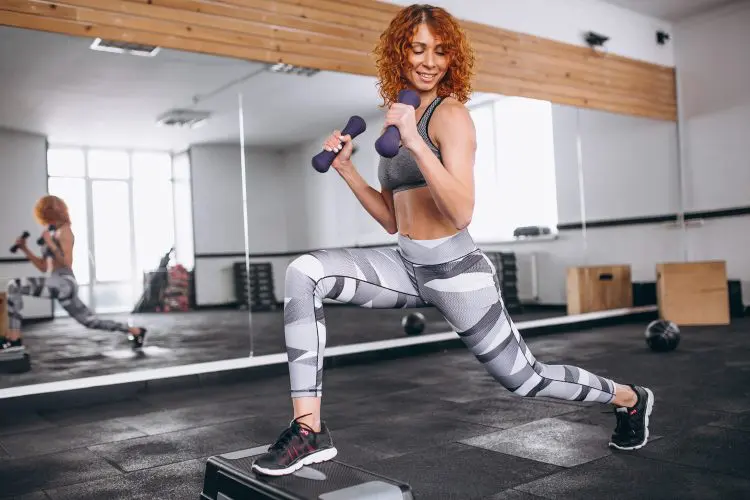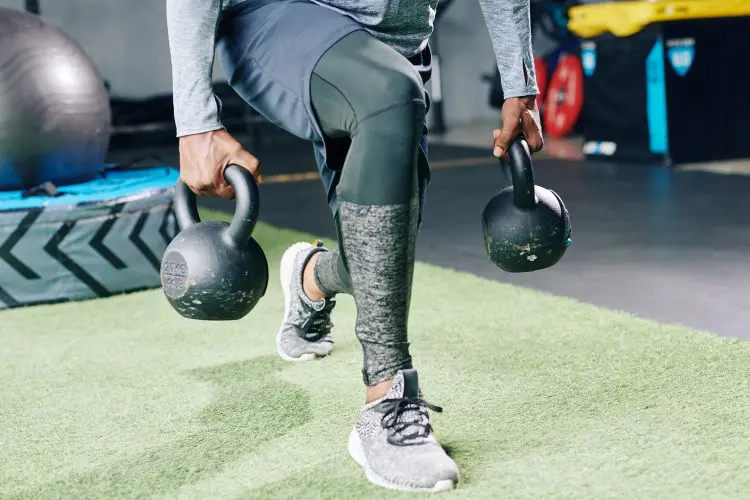When to comes to building lower body strength and muscle size, squats, leg presses, and deadlifts are hard to beat. After all, these exercises are ideally suited for heavy weights. But, as good as these exercises are, they do have disadvantages.
For starters, all of those exercises are bilateral, which means they use two legs at once. While that’s good for building strength and size, many real-life movements are unilateral, meaning they use one leg at a time. Walking, running, kicking, climbing stairs – these are all examples of unilateral movements.
Also, bilateral exercises like squats and deadlifts put a lot of strain on your spine. Heavy squats and deadlifts can take their toll on your lower back and compress all of your vertebrae. For some exercisers, this is a major drawback.
Finally, with bilateral exercises, it’s all too easy to use one limb more than another. You might not even realize that you have a left to right strength discrepancy. Minor imbalances are nothing to worry about, but significant strength imbalances can affect your posture and even cause injuries.
Because of this, most exercisers should also include unilateral leg exercises in their workouts. There are plenty to choose from, but lunges are one of the best.
In this detailed article, penned by fitness expert Patrick Dale and meticulously updated by Tom Miller, CSCS, we aim to provide our deep insights into this essential exercise, presenting the 10 best progressions and variations. With our combined expertise and passion for fitness, this article promises to be an authoritative guide for all things related to lunges.
Level Up Your Fitness: Join our 💪 strong community in Fitness Volt Newsletter. Get daily inspiration, expert-backed workouts, nutrition tips, the latest in strength sports, and the support you need to reach your goals. Subscribe for free!
How to do Lunges
Lunges are a very effective lower body exercise, but only if you do them right! Follow these steps to make every rep you perform is as productive and safe as possible.
Steps:
- Stand tall with your feet together and your hands by your sides. Look straight ahead and not down at the floor. Brace your abs.
- Take a large step forward and into a split stance.
- Bend your legs and lower your rearmost knee down within about an inch of the floor. Do not let it touch down.
- Your front shin should be vertical or very close to it. Do NOT let it move forward past your toes, as doing so puts a lot of stress on the knee joint.
- Your rear thigh should also be close to vertical.
- About 60-70% of your weight should be on your front leg.
- Push off your front leg and return to the starting position.
- Do all your reps leading with the same leg or alternate legs as preferred.
Lunge Anatomy
Lunges are a compound exercise. That means they involve two or more joints and lots of different muscles working together. Because of this, lunges are a very time-efficient exercise.
The main muscles involved in lunges are:
- Quadriceps – known as the quads for short, these are the four muscles on the front of your thighs. The four quads are rectus femoris, vastus lateralis, vastus medialis, and vastus intermedius. The primary role of the quadriceps is knee extension.
- Hamstrings – located on the back of your thighs, the hamstrings flex your knees and extend your hips. There are three hamstrings: biceps femoris, semimembranosus, and semitendinosus.
- Gluteus maximum – called the glutes for short, gluteus maximus is the large muscle on the back of your hip. Its main function is hip extension.
- Hip adductors – the hip adductors are the muscles on the inside of your thigh. In lunges, they act as stabilizers to stop your knees from falling outward. The adductors are longus, brevis, and magnus.
- Hip abductors – located on the outside of your hip and thigh, this group of muscles stops your knees from falling inward as you lunge. The hip abductors are gluteus minimus, medius, and tensor fascia latae, or TFL for short.
- Core – the collective term for the muscles of your midsection, the core stabilizes your spine during lunges. Different types of lunges require different levels of core recruitment but, even in basic lunges, your core plays an important role.
Lunge Benefits and Advantages
What makes lunges such a good exercise? Good question! The main benefits and advantages of lunges are:
1. Lunges can lead to better sports performance
There are very few bilateral athletic movements, with rowing, powerlifting, and Olympic lifting being the main exceptions. All of the rest are unilateral movements. If you play any sport, your workouts should include lunges.
That’s why lunges made it on to our list of The 12 Best Strength Training Exercises for Runners.
2. Lunges are good for joint mobility
Lunges involve a large range of motion, especially for your hips. This provides the surrounding muscles with a beneficial stretch. Better hip mobility can help reduce hip pain, reduce your risk of hip injuries, and also increase functionality.
3. Lunges are easy on your joints
Done correctly, lunges are generally easier on your knees than squats and leg presses. If you’ve got painful knees, lunges could be one of the few exercises you can do without discomfort. However, some lunge variations are more knee-friendly than others, such as backward or reverse lunges.
4. Lunges are very scalable
Some short-sighted exercisers dismiss lunges because they think they’re too easy or best left to beginners. The truth is that there are lots of different types of lunges, and most of them can be made intense enough for even the most hardcore lifter. Beginner, intermediate, and advanced exercisers can all benefit from regular lunges.
5. Lunges work one leg at a time
We’ve mentioned this benefit already, but it’s so important it’s worth repeating. Lunges emphasize one leg at a time, which is useful for increasing functional strength, improving athleticism, and fixing any left to right strength imbalances.
Here at Fitness Volt, we LOVE the classic bilateral leg exercises (squats, leg presses, deadlifts, cleans, etc.). Still, we also understand that you need more than two-limbed leg exercises to build the best possible lower body.
6. Lunges can be done with or without weights
Lunges are one of those exercises that can be done with nothing more than your body weight for resistance, but you can also do them with dumbbells, a barbell, and other types of weight. Whether you train in a gym or in your garage, you can reap the benefits of lunges.
Lunge Variations
Basic lunges are a very beneficial exercise, but if that’s the only variation you do, your workouts will soon become boring and unproductive. Here are a whole lot of different lunge variations to try.
1. Static Lunge
If regular lunges are a little too challenging for you right now, you may prefer static lunges, which involve less movement and coordination. Also known as split squats, this exercise is ideal for beginners and anyone whose balance is not as good as it could be.
Learn how to do split squats in our in-depth guide.
2. Walking Lunges
If you’ve got the space, walking lunges are a great alternative to more stationary types of lunges. Instead of doing them for a set number of reps, you can do walking lunges for a predetermined distance instead, such as 30-yards.
On the downside, walking lunges do require additional balance and control, making them a more advanced exercise than regular lunges. You must also take care not to let your front knee travel forward and beyond your toes, which is a common walking lunge fault.
How to do it:
- Stand tall with your feet together and your hands by your sides. Look straight ahead and not down at the floor. Brace your abs.
- Take a large step forward and into a split stance.
- Bend your legs and lower your rearmost knee down within about an inch of the floor. Do not let it touch down.
- Push off with your back leg and step forward into another lunge.
- Continue alternating legs until you have done the prescribed number of reps or distance.
3. Reverse Lunges
Reverse or backward lunges are usually easier on the knees and also work your glutes and hamstrings more than forward lunges. Most people find it easier to keep their front shins vertical when doing reverse lunges.
How to do it:
- Stand tall with your feet together and your hands by your sides. Look straight ahead and not down at the floor. Brace your abs.
- Take a large step backward and bend your legs. Lower your rearmost knee down to within an inch of the floor.
- Push off your back leg and bring your feet back together.
- Do all your reps leading with the same leg or alternate legs as preferred.
Watch as Enrique Santatecla, Fitness Volt’s experienced powerlifting coach, guides you through the correct form of reverse lunges:
4. Step-through Lunges
This move combines forward and backward lunges into one exercise. It’s a demanding exercise that requires good balance and coordination. Because of the increased time under tension, this exercise is useful for anyone looking to make lunges more challenging but doesn’t want to use weights.
How to do it:
- Stand tall with your feet together and your hands by your sides. Look straight ahead and not down at the floor. Brace your abs.
- Take a large step forward, bend your legs, and lower your rear knee down to within an inch of the floor.
- Push off your front leg and step back into a reverse lunge. Do not “touch down” as you move between forward to backward lunges.
- Push off your back leg and move into another forward lunge.
Expert Demonstration – Powerlifting coach Enrique Santatecla from Fitness Volt showcases the proper technique for step-through Lunges in this video:
5. Lateral Lunges
Lateral or side lunges increase abductor and adductor activation. If you play sports that involve multi-directional movements, such as tennis, soccer, or hockey, this will be a beneficial exercise. It also provides an excellent stretch for the hips.
Watch certified coach Enrique Santatecla demonstrates the key steps for executing Lateral Lunges effectively in this detailed guide:
Learn how to do this exercise correctly with our detailed guide.
Level Up Your Fitness: Join our 💪 strong community in Fitness Volt Newsletter. Get daily inspiration, expert-backed workouts, nutrition tips, the latest in strength sports, and the support you need to reach your goals. Subscribe for free!
6. Deficit Lunges (forward or backward)
Deficit lunges involve stepping onto or off a raised surface. This increases your range of motion to make your chosen exercise more demanding. You can add a deficit to most types of lunges. Use a 4 to 6-inch platform, ensure that it won’t move during your workout, and check that it’s strong enough to support your weight.
While you COULD use a higher platform, this is not usually a good idea, as a very large range of motion could place too much stress on your joints.
Examples of deficit lunges include:
- Forward lunges onto a platform
- Backward lunges off a platform
- Lateral lunges off a platform
- Step-through lunges with your supporting foot on a platform
7. Plyometric Lunges
Plyometric or jumping exercises increase explosive power. Power is your ability to generate force quickly and is a vital part of most sports. Whether you want to run faster, kick harder, or jump higher, plyometric lunges could help.
How to do it:
- Stand tall with your feet together and your hands by your sides. Look straight ahead and not down at the floor. Brace your abs.
- Take a large step forward, bend your legs, and lower your rear knee down to within an inch of the floor.
- Using your arms for extra momentum, jump up and into the air. Sweep your rear leg forward and your front leg back so that you land with your feet reversed.
- Descend into another rep and repeat.
- Try to land and go, and do not pause between reps. Imagine the ground is red-hot to minimize contact time.
8. Rotational Lunges
While all lunge variations involve an element of core engagement, this variation is much more core-centric. In addition, rotational lunges are more challenging for your balance. This exercise is very useful for racket sports players, such as tennis, as well as golfers.
How to do it:
- Stand tall with your feet together and your hands by your sides. Look straight ahead and not down at the floor. Hold a weight in your hands, such as a medicine ball. Raise your arms overhead and brace your abs.
- Take a large step forward, bend your legs, and lower your rear knee down to within an inch of the floor.
- Simultaneously lower your arms and turn toward your leading leg. Lower the weight to the outside of your front thigh.
- Push off your front leg, return to the starting position, and repeat. Alternate leading legs rep by rep or do all your reps on the same side before switching as preferred.
9. Lunge with Forward Reach
With most types of lunges, you should try to keep your torso reasonably upright. It’s okay to lean forward a little, but no more than a few degrees. Lean forward just enough to avoid hyperextending your lumbar spine.
With this variation, you purposely lean forward to increase glute and hamstring activation. You can add forward reaches to both regular and reverse lunges. However, you must lean forward from your hips and not round your lower back. Rounding your lower back, even during lunges, could cause back pain and injuries.
To do this exercise, perform your chosen lunge as usual but then hinge forward from your hips, reaching down toward your front foot. This simple modification will make your lunge more posterior chain-centric.
10. Weighted Lunges
All of the lunge variations described above can be done using just bodyweight OR with a form of external resistance. However, there are several ways and methods you can use to turn your bodyweight lunges into the weighted version.
Options include:
- Two dumbbells/kettlebells
- One dumbbell/kettlebell
- A barbell on your back
- A barbell in the front squat position
- A barbell in the cork of your arms in the Zercher squat position
- A kettlebell or dumbbell in the goblet squat position
- Barbell or dumbbells held overhead
- Medicine ball
- Sandbag
If you do weighted lunges, remember that holding weights down by your side is generally easier than holding them at shoulder-level or above. Also, using just one weight will increase deep core activation, as you’ll have to work harder to keep your torso upright.
Using weights makes any type of lunge more demanding and also provides you with an alternative to doing more reps as a method of progressive overload.
Important Lunge Performance Tips
Get the most from this exercise by implementing the following lunge tips!
Mix it up
Don’t fall into the trap of doing the same type of lunge all the time. That’s an excellent way to get stuck in a training rut. Instead, mix up your workouts by using the variations listed above and changing how you use resistance.
For example, you could do forward lunges with dumbbells one week and walking goblet lunges the next. The combinations are almost infinite, and there is no reason ever to get bored of lunges.
Take care not to hyperextend your hips
Some exercisers keep their rear leg straight when doing lunges. This is a mistake that could lead to hip pain and joint and muscle injuries. Make sure you bend your front AND back leg to prevent hip hyperextension. After all, we’re doing lunges mainly for their muscle strengthening effect and not as stretches.
Do not let your knees collapse
Lunges test and develop your balance. This is one of their benefits. But, if your personal balance is not as good as it could be, lunges could lead to knee pain and injuries.
Make sure that, when you are lunging, your knees do not fall in or out. Instead, they should track directly above your ankle joints. If you notice that your knees are collapsing, regress to a less demanding lunge variation. You may also need to strengthen your hip abductors and adductors to increase joint stability.
Use the right rep range and weight for your goals
You’ll get more from lunges if you do the number of reps that matches your reason for training. The accepted rep ranges by goal are:
- Strength/power – 1-5 reps @ 85%+ of your one repetition maximum (1RM)
- Hypertrophy – 6-12 reps 67-85% of your 1RM
- Endurance – 13-20 reps 50-67% of your 1RM
It’s not a good idea to do lunges with very heavy weights. Losing your balance with a heavy load could lead to injury. Instead, if you are training for peak strength, you should use lunges as an accessory exercise after your main lifts. However, power exercises like plyometric lunges work best when done for low reps. That way, you can focus on jumping as high as you can.
Lunges and BFR
Try lunges with blood flow restriction training – lunges work really well with BFR training. Without weights, BFR lunges will quickly pump up and fatigue your muscles, leading to muscle mass and strength increases. Try doing alternate leg BFR lunges using Tabata intervals for a skin-splitting lower body workout that only lasts four minutes.
FAQ’s
What are lunges good for?
Lunges are a versatile lower-body exercise that strengthens and tones the glutes, quadriceps, and hamstrings, while also improving balance and stability. They are beneficial for overall leg development, enhancing flexibility, and correcting muscle imbalances.
How to do a correct lunge?
To perform a correct lunge, stand with your feet hip-width apart, step forward with one foot, and lower your body until both knees are bent at a 90-degree angle, ensuring your front knee is directly above your ankle, and your back knee hovers above the ground. Remember to keep your torso upright and engage your core throughout the movement.
Do lunges work hamstrings?
Lunges are an effective exercise for working the quadriceps, hamstrings, and gluteal muscles. To place a greater emphasis on the hamstrings, consider leaning forward slightly during the movement. This adjustment will also activate the gluteus medius muscle more significantly. Conversely, maintaining an upright torso will target the quadriceps to a greater extent.
Are lunges or squats better?
While both lunges and squats are excellent exercises for lower-body strength and conditioning, lunges have the advantage of working each leg independently, which can help to address muscle imbalances and improve coordination and stability.
Do lunges reduce belly fat?
While lunges can be an effective exercise for strengthening the muscles in your lower body and potentially aiding in fat loss, they are not specifically targeted to reduce belly fat. To lose belly fat, a comprehensive approach that includes a balanced diet, regular cardiovascular exercise, and full-body strength training is recommended.
Is it okay to do lunges on a daily basis?
While it is possible to include lunges in your daily workout routine, it is essential to monitor the intensity to avoid overtraining. A more effective approach would be to train the leg muscles at a higher intensity twice per week, with a rest day in between sessions to allow for optimal muscle recovery and tissue repair.
Wrapping Up
It’s all too easy to forget how versatile and effective lunges are. After all, they are quite a common exercise. But, done right, they are one of the most useful and productive leg exercises you can do. Better yet, there are lots of different variations you can use to keep your workouts fresh and interesting.
Squats, deadlifts, and leg presses will always be our favorite lower body exercises, especially for building muscle mass and strength. But, for improving balance, mobility, and athleticism, lunges really are tough to beat.
Build your best lower body ever, one leg at a time, by adding lunges to your strength training workouts. Whatever you are training for, lunges will help you get there sooner.
Interested in measuring your progress? Check out our strength standards for Zercher Squat, Goblet Squat, Clean, and more.











